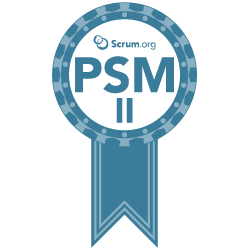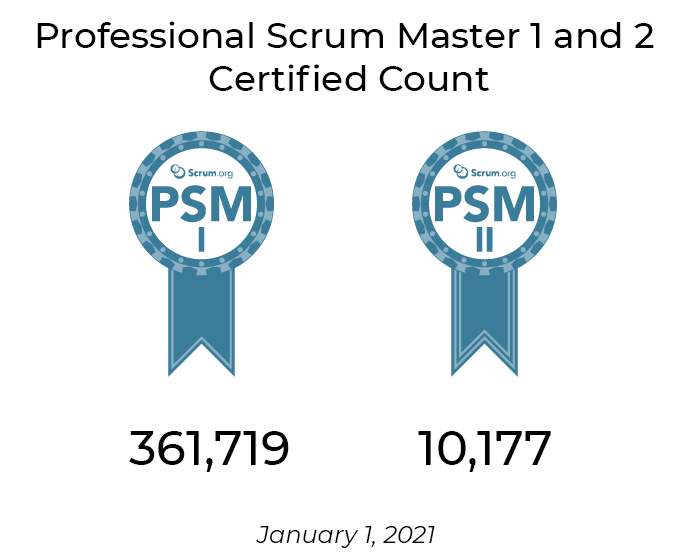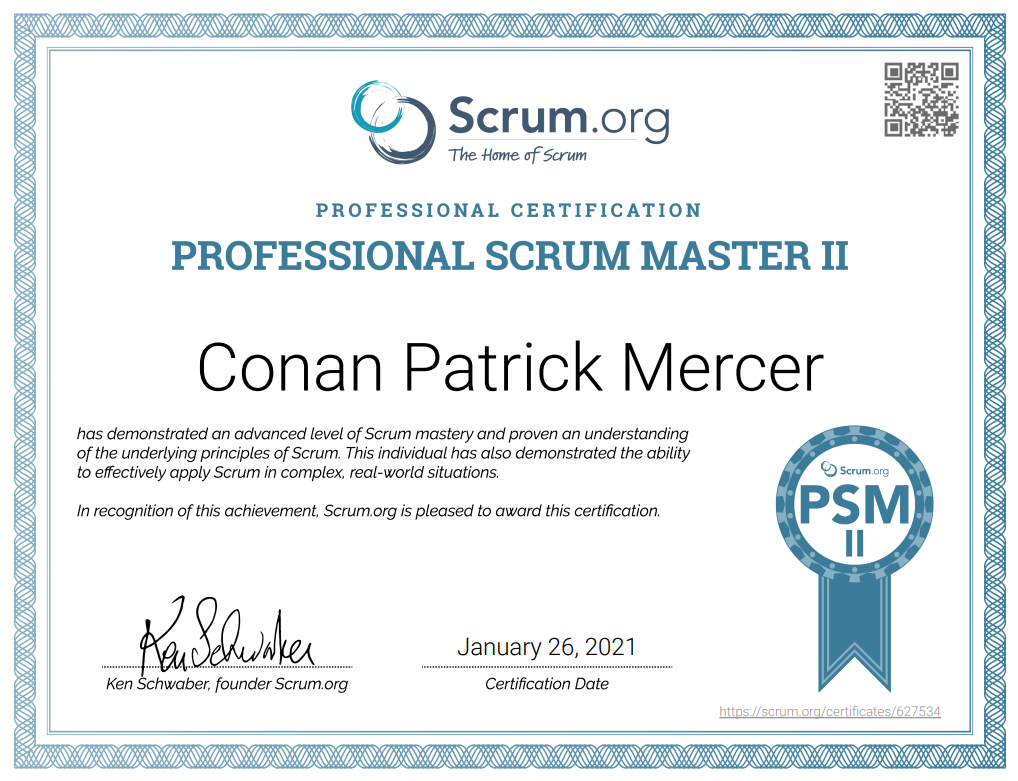Conan Mercer Site Reliability Engineering Leader
My Road To Professional Scrum Master II Certification
26 Jan 2021 - Conan Mercer

The Road to Certification
I had been the Scrum Master in a company for almost 2 years. I had taken the initial Professional Scrum Master I certification and was successful. I have written about this process in a previous post here.Next I wanted to prepare for and take the much more advanced certification, the Professional Scrum Master II.
In this post I offer some advice, tips and strategies to passing the exam, the first time around.

Increased value
The reasons why any qualification is valuable depends on many variables. It is widely accepted that if a very large number of people hold a certain qualification globally, its value is somewhat diminished. In the case of the Scrum Master certifications, many people hold the Professional Scrum Master I certification, compared to far less that hold the Professional Scrum Master II certification. To compare in terms of percentages, only 2.8% of people hold the PSM II compared to the PSM I.Figure 1 below shows the latest certified count as of January 1st, 2021.

Preparation
Working in a company that is using the Scrum framework is helpful, however be very careful in this situation. Most company's do not use pure Scrum, they often use ScrumBut. I have talked about the dangers of this in a previous post here.I spent a lot more time on this exam than the first PSM 1 exam. I noted down any good ideas I had read in the books below, I then attempted to implement them as Scrum Master in the company I was working for at the time. I would watch and observe what worked and what did not work. Always, I referred back to the Scrum Guide regularly to check if what I was trying to implement was actually Scrum. I cannot stress the importance of this enough. The effective implementation of Scrum requires constant inspection, transparency and adaptation. If you feel yourself becoming complacent, quickly correct your course. Scrum is a learning process that arguably, never ends.
There are a lot of PSM 2 training programs available online and in person, these are often expensive, and in my opinion not necessary to pass the exam. Avoid these unless you have no working experience with Scrum.
Besides this, I also did the following:
- took the free official Scrum OPEN exam 5 times
- took the free official Scrum Developer OPEN exam 5 times
- took the free official Product Owner OPEN exam 5 times
- read the Scrum Guide thoroughly
- read the Nexus Guide thoroughly
- took the PSM I Preparation Quiz from Mikhail Lapshin 5 times
- read the Scrum Glossary and made sure I knew all the terms
- read and understood the professional scrum competencies
- "Extreme Ownership: How U.S. Navy SEALs Lead and Win" by Jocko Willink
- "Adapt: Why Success Always Starts with Failure" by Tim Harford
- "Reinventing Organizations" by Frederic Laloux
- "Scrum Mastery: From Good To Great Servant-Leadership" by Geoff Watts
- "Scrum: A Pocket Guide: A Smart Travel Companion" by Gunther Verheyen

The Day of the Exam
I took the exam after a full working day. I would have normally preferred to take the exam in the morning, but on this occasion it worked out better for me to take it in the evening. I made sure that I had eaten food about 1 hour before the exam, and was well hydrated. For about 30 mins before the exam, I read the Nexus guide once. This is because it was the only part of the exam that I thought I might have issues with, as I had never scaled Scrum before within an organization.Just before the exam, I made certain that I was in a relaxed mood in a quite place with low probability of being disturbed.
During the Exam
You have exactly 90 minutes to complete all 30 questions. This gives you approximately 3 mins to read, comprehend and answer each question. This is much more time than the PSM 1 exam, which only allows about 45 seconds per question. I finished all of the questions in about 40 minutes which gave me about 50 minutes to recheck any question that I had flagged. I spent a further 30 mins checking all of my flagged questions, re-reading the question and then making sure to change an answer if I thought it was wrong. I changed about 2 or 3 answers. I had about 20 mins left when I submitted my exam. For me time was not an issue at all for this exam.The importance of the Nexus guide
The exam does feature questions related to scaling Scrum. So I was thankful that I had read the Nexus guide before hand, and in the months leading up to the exam. For me I had no formal experience scaling Scrum, so it was a potential weak point. However, because I had put specific effort in here, the questions related to scaling Scrum where not too challenging. I would definitely recommend getting familiar with scaling Scrum if you also do not have significant working experience here.The bar to pass
To pass the exam it is required to score 85% or higher. This sets the bar high and does not allow much wiggle room for incorrect answers.After the Exam
After the exam you are sent an email with your score and a breakdown of areas for improvement. You do not receive specifics on what questions you failed and their correct answers, this is one of the many ways that the Scrum certification process is respected in industry. The integrity of this exam is high as a real exam question "bank" does not exist.Your certificate is also searchable and verifiable by anyone via the Scrum.org website, cold hard proof of your success. You also receive a high quality pdf of your certificate, with your full name and the date you passed the exam, see Figure 2.
